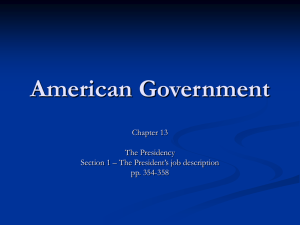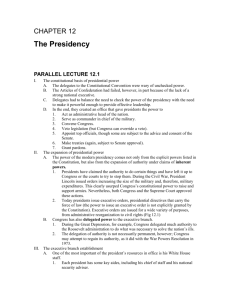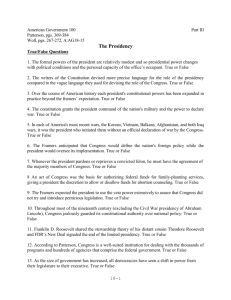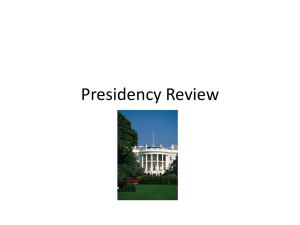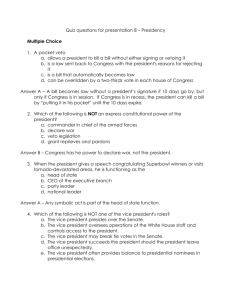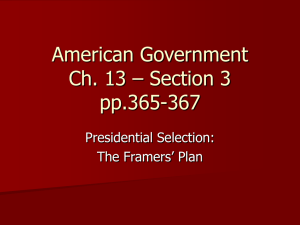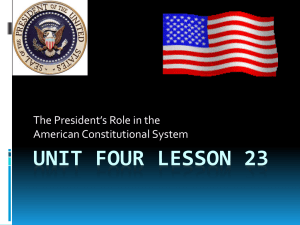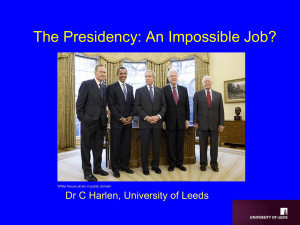Chapter 12 Student Study Guide
advertisement
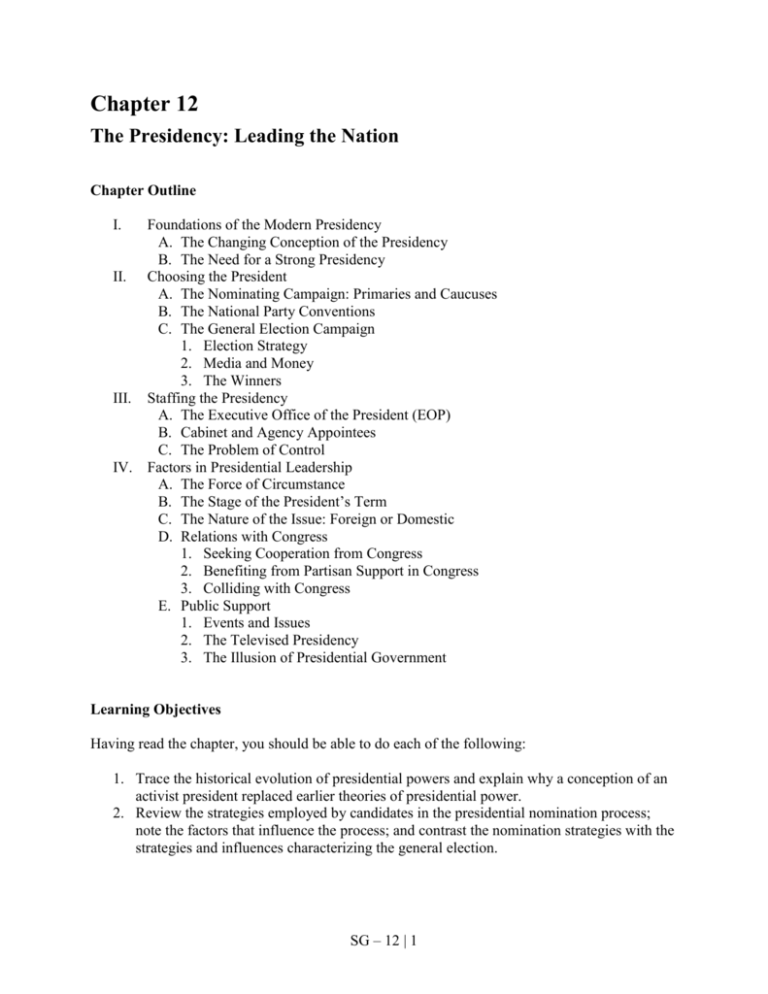
Chapter 12 The Presidency: Leading the Nation Chapter Outline I. Foundations of the Modern Presidency A. The Changing Conception of the Presidency B. The Need for a Strong Presidency II. Choosing the President A. The Nominating Campaign: Primaries and Caucuses B. The National Party Conventions C. The General Election Campaign 1. Election Strategy 2. Media and Money 3. The Winners III. Staffing the Presidency A. The Executive Office of the President (EOP) B. Cabinet and Agency Appointees C. The Problem of Control IV. Factors in Presidential Leadership A. The Force of Circumstance B. The Stage of the President’s Term C. The Nature of the Issue: Foreign or Domestic D. Relations with Congress 1. Seeking Cooperation from Congress 2. Benefiting from Partisan Support in Congress 3. Colliding with Congress E. Public Support 1. Events and Issues 2. The Televised Presidency 3. The Illusion of Presidential Government Learning Objectives Having read the chapter, you should be able to do each of the following: 1. Trace the historical evolution of presidential powers and explain why a conception of an activist president replaced earlier theories of presidential power. 2. Review the strategies employed by candidates in the presidential nomination process; note the factors that influence the process; and contrast the nomination strategies with the strategies and influences characterizing the general election. SG – 12 | 1 3. List the major organizations that make up the Executive Office of the President and explain each organization’s area of policy expertise and its powers under the modern presidency. 4. Assess the effects of staffing on the president’s control of executive authority. 5. Discuss and explain the factors that make for a successful presidency. 6. Summarize the two presidencies thesis. Explain the strengths and weaknesses of the thesis, citing historical examples where appropriate. 7. List the major stipulations of the War Powers Act and discuss the extent to which the legislation has accomplished its purpose. 8. Explain how the nature of national circumstances can affect presidential power both positively and negatively. 9. Analyze the relationship between the executive and Congress and assess the ability of either institution to set policy independently of the other. 10. Describe why the president generally has a freer hand in foreign policy and how presidential power is enhanced on foreign issues. 11. Detail the methods by which presidents court public support, and how high or low levels of public support can affect presidential power. Chapter Summary The presidency has become a much stronger office than the framers envisioned. The Constitution grants the president substantial military, diplomatic, legislative, and executive powers, and in each case the president’s authority has increased measurably over the nation’s history. Underlying this change is the president’s position as the one leader chosen by the whole nation and as the sole head of the executive branch. These features of the office have enabled presidents to claim broad authority in response to the increased demands placed on the federal government by changing global and national conditions. During the course of American history, the presidential selection process has been altered in ways intended to make it more responsive to the preferences of ordinary people. Today, the electorate has a vote not only in the general election but also in the selection of party nominees. To gain nomination, a presidential hopeful must win the support of the electorate in state primaries and open caucuses. Once nominated, the candidates are eligible to receive federal funds for their general election campaigns, which today are based on Internet and televised appeals. Although the campaign tends to personalize the presidency, the responsibilities of the modern presidency far exceed any president’s personal capacities. To meet their obligations, presidents have surrounded themselves with large staffs of advisers, policy experts, and managers. These staff members enable the president to extend control over the executive branch while at the same time providing the information necessary for policymaking. All recent presidents have discovered, however, that their control of staff resources is incomplete and that some things others do on their behalf can work against what they are trying to accomplish. SG – 12 | 2 As sole chief executive and the nation’s top elected leader, presidents can always expect that their policy and leadership efforts will receive attention. However, other institutions, particularly Congress, have the authority to make presidential leadership effective. No president has come close to winning approval of all the programs he has placed before Congress, and presidents’ records of success have varied considerably. The factors in a president’s success include whether national conditions that require strong leadership from the White House are present and whether the president’s party has a majority in Congress. Presidential success stems from the backing of the American people. Recent presidents have made extensive use of the media to build public support for their programs, yet they have had difficulty maintaining that support throughout their terms of office. A major reason is that the public expects far more from its presidents than they can deliver. Focus and Main Points A historical perspective of the evolution of the presidency is offered in this chapter, as well as an explanation of the steady increase in its power, surpassing the original intent of the framers of the U.S. Constitution. The author also examines the presidential selection process and the staffing of the modern presidency, both of which contribute to the president’s prominence in the American political system. The various broad factors that can affect the efficacy of presidential leadership are also explored, including the force of circumstance, relationship with Congress, and the level of support of the public. The main points in this chapter are as follows: Over time, the presidency has become a powerful office. This development owes largely to the legacy of strong presidents and to domestic and international developments that have increased the need for executive leadership. The modern presidential campaign is a marathon affair in which self-selected candidates seek a strong start in the nominating contests and a well-run media campaign in the general election. The president could not control the executive branch without a large number of presidential appointees—advisors, experts, and skilled managers—but the sheer number of these appointees is itself a challenge to presidential control. The president’s election by national vote and position as sole chief executive make the presidency the focal point of national politics. Nevertheless, whether presidents are able to accomplish their goals depends on their personal capacity for leadership, national and international conditions, the stage of their presidency, the partisan composition of Congress, and whether the issue is foreign or domestic. SG – 12 | 3 Major Concepts Whig theory A theory that prevailed in the nineteenth century and held that the presidency was a limited or restrained office whose occupant was confined to expressly granted constitutional authority. stewardship theory A theory that argues for a strong, assertive presidential role, with presidential authority limited only at points specifically prohibited by law. open party caucuses Meetings at which a party’s candidates for nomination are voted on and that are open to all the party’s rank-and-file voters who want to attend. momentum (in campaigns) A strong showing by a candidate in early presidential nominating contests, which leads to a buildup of public support for the candidate. unit rule The rule that grants all of a state’s electoral votes to the candidate who receives the most popular votes in the state. White House Office (WHO) A subunit of the Executive Office of the President (EOP), the White House Office is the core of the presidential staff system in that it includes the president’s closest and most trusted personal advisors. cabinet A group consisting of the heads of the executive (cabinet) departments, who are appointed by the president, subject to confirmation by the Senate. The cabinet was once the main advisory body to the president, but it no longer plays this role. honeymoon period The president’s first months in office, a time when Congress, the press, and the public are more inclined than usual to support presidential initiatives. presidential approval ratings A measure of the degree to which the public approves or disapproves of the president’s performance in office. SG – 12 | 4 Practice Exam (Answers appear at the end of this chapter.) Multiple Choice 1. In Federalist No.76, Alexander Hamilton declared that the president’s real authority as chief executive is a. the power to appoint. b. the power to declare war. c. the power to receive ambassadors. d. the power to make treaties. e. both the power to declare war and the power to make treaties. 2. Theodore Roosevelt was a proponent of a. Whig theory. b. stewardship theory. c. executive theory. d. modern theory. e. elastic theory. 3. Signing statements a. are written statements by the president to indicate that an executive order is to be carried out even if it conflicts with existing legislation. b. are attached by the president to proposed legislation to indicate that the president will veto the legislation should it pass Congress. c. are attached to legislation proposed indirectly by the president to indicate that said legislation would not earn a veto if passed in its current form. d. are appended to a bill when the president signs it and are meant to indicate that the president does not necessarily intend to abide by particular provisions of a law. e. are statements of objection that a lawmaker may attach to a bill even though that bill has passed the lawmaker’s branch of Congress. 4. Since Andrew Jackson’s time, ________ have won the presidency after having lost the popular vote. a. Samuel Tilden (1876), Grover Cleveland (1888), and Harry Truman (1948) b. Rutherford B. Hayes (1876), Benjamin Harrison (1888), and George W. Bush (2000) c. Ulysses S. Grant (1868), Benjamin Harrison (1888), and George W. Bush (2000) d. James Garfield (1880), Woodrow Wilson (1912), and Richard Nixon (1968) e. James Buchanan (1856), Woodrow Wilson (1912), and George W. Bush (2000) 5. ________ was the last major-party candidate to win his party’s nomination without entering any primaries. a. Richard Nixon (1968) b. Barry Goldwater (1964) c. Hubert Humphrey (1968) d. George McGovern (1972) e. Jimmy Carter (1976) SG – 12 | 5 6. Less than ________ percent of Americans say that they would not vote for a female president. a. 50 b. 40 c. 30 d. 20 e. 5 7. The three states with the highest number of votes in the Electoral College are a. New York, Florida, and Pennsylvania. b. Texas, Illinois, and Ohio. c. California, Texas, and New York. d. Illinois, Pennsylvania, and Michigan. e. Georgia, North Carolina, and Texas. 8. ________ are the two states that do not use the unit rule in the Electoral College. a. California and New Jersey b. Florida and Georgia c. Nevada and Utah d. Maine and Nebraska e. New Hampshire and Vermont 9. Which of the following is NOT a formal requirement for becoming president? a. The individual must be 35 years old. b. The individual must be a natural-born citizen. c. The individual must be a resident in the United States for at least 14 years. d. The individual must be resident of the same state for at least five years. e. None of these answers is correct, as all are formal requirements for becoming president. 10. Which of the following is true of the president and foreign policy? a. Presidential executive agreements with other countries are not legally binding in the way formal treaties are. b. The framers anticipated that Congress would implement the president’s foreign policy agenda. c. The framers anticipated that the president would define the nation’s foreign policy objectives. d. Ambassador appointments made by the president are subject to approval by a twothirds vote of the House of Representatives. e. Treaties made by the president are subject to approval by a two-thirds vote of the Senate. SG – 12 | 6 11. Which of the following was an action of Theodore Roosevelt that implemented his theory of presidential stewardship? a. forcing Congress to meet in unscheduled open sessions b. removing unfriendly Supreme Court justices from office c. rejecting the Senate’s power to approve treaties d. challenging the power of business monopolies e. taking the country into World War I 12. Which organization was created in 1939 to provide the president with staff necessary to coordinate the activities of the executive branch? a. Legislative Liaison Staff b. National Security Council c. State Department d. Department of Defense e. Executive Office of the President 13. ________ were impeached by the U.S. House of Representatives. a. Richard Nixon and Bill Clinton b. Bill Clinton and James Polk c. Richard Nixon and Andrew Johnson d. James Polk and Andrew Johnson e. Bill Clinton and Andrew Johnson 14. Which of the following is true of President George W. Bush’s relationship with Congress? a. He cast only two vetoes in his first five years of his presidency. b. He got almost nothing he asked for from Congress in the early years of his presidency. c. In the early years of his presidency, he got most of what he asked for from Congress. d. His relationship with Congress became less contentious during the later years of his presidency. e. He exercised more vetoes in the early years of his presidency than any other twentieth-century president. 15. ________ used the presidency as a “bully pulpit.” a. Theodore Roosevelt b. Calvin Coolidge c. Warren Harding d. William Howard Taft e. Herbert Hoover 16. The EOP body that advises the president on economic issues is the a. Federal Reserve. b. Presidential Economic Council. c. Executive Financial Planning Office. d. National Economic Council. e. Treasury Office. SG – 12 | 7 17. ________ was the president to champion the national convention as a means of nominating the presidential candidates of political parties. a. George Washington b. Thomas Jefferson c. Andrew Jackson d. James Madison e. James Monroe 18. Which of the following presidents did NOT serve as vice president? a. Lyndon Johnson b. Richard Nixon c. Gerald Ford d. George H. W. Bush e. George W. Bush 19. How many total votes are there in the Electoral College system? a. 435 b. 538 c. 535 d. 600 e. 750 20. The ________ is in the Executive Office of the President. a. National Security Council b. White House Office c. Office of Management and Budget d. National Economic Council e. All these answers are correct. True/False 1. In practice, the presidency is a more powerful office than the framers envisioned it would be under the Constitution. a. True b. False 2. The Whig theory of the presidency calls for limited use of powers based on expresslygranted constitutional authority. a. True b. False 3. A key to success in presidential nomination campaigns is “momentum.” a. True b. False SG – 12 | 8 4. The electoral vote for president has always been tied to the popular vote. a. True b. False 5. The Constitution very clearly gives the vice president responsibility over some areas of executive authority. a. True b. False 6. Historically, presidents have put forth most of their program initiatives early in their administrations. a. True b. False 7. Significant presidential action can often succeed without the approval of Congress or the cooperation of the bureaucracy, and sometimes even without the acceptance of the judiciary. a. True b. False 8. The War Powers Act was passed to curb presidential authority. a. True b. False 9. The presidency is unique among American elected officials because presidents can claim to represent the whole nation. a. True b. False 10. Presidential success is related to party support in Congress. a. True b. False Essay 1. Explain the differences between Whig theory and stewardship theory. SG – 12 | 9 2. Explain the four systems of presidential selection in U.S. history. 3. Explain how the Electoral College works today. 4. Why are presidents a bit more likely to get what they want in foreign policy than in domestic policy? 5. What is meant by “the illusion of presidential government”? SG – 12 | 10 Answers to the Practice Exam Multiple Choice Answers 1. a 2. b 3. d 4. b 5. c 6. e 7. c 8. d 9. d 10. e 11. d 12. e 13. e 14. c 15. a 16. d 17. c 18. e 19. b 20. e Multiple Choice Explanations 1. In Federalist No.76, Hamilton argued that the essence of the president’s power is appointive (a). Presidents have discovered, however, that the power to execute laws is of even greater value. 2. When Theodore Roosevelt became president in 1901, he rejected Whig theory. Instead, he embraced stewardship theory (b), which emphasizes an assertive presidency that is confined only by matters that are specifically prohibited by law. 3. Signing statements are statements appended to a bill when the president signs it, and indicate that the president does not necessarily intend to abide by particular provisions of a law; thus, the answer is (d). 4. Since President Jackson, who served from 1829 to 1837, Hayes (1876), Harrison (1888), and Bush (2000) all lost the popular vote but won the presidency via the Electoral College (b). 5. Humphrey (c) won the Democratic nomination in 1968 even though he did not enter a single primary. He lost the general election, which inspired the Democratic Party leadership to reform the way in which candidates for president were selected. 6. Less than 5% (e) of Americans state that they would not vote for a female president. 7. The correct answer is (c)—California (55), Texas (34), and New York (31). 8. Today, every state but two awards all its electoral votes to the popular vote winner. The two exceptions are Maine and Nebraska (d), which use the district plan. 9. There are three formal requirements for being president under Article II of the Constitution, and being a resident of the same state for any length of time (d) is not one of them. 10. The Constitution also empowers the president to act as diplomatic leader with the authority to appoint ambassadors and to negotiate treaties with other countries, subject to approval by a two-thirds vote of the Senate. Thus, the answer is (e). SG – 12 | 11 11. Theodore Roosevelt acted on his belief in a strong presidency, what he called the stewardship theory, in part by challenging the power of business monopolies. Thus, the answer is (d). 12. The Executive Office of the President (e) includes such entities as the cabinet, the National Security Council, the Legislative Liaison Staff, and 18 other units. 13. Johnson and Clinton (e) were impeached by the House but exonerated in their Senate trials. Nixon resigned from office shortly before the House vote on impeachment. 14. President George W. Bush had a very cooperative relationship with Congress early on and got almost everything he asked for (c), which is the reason he went for five years before casting his first veto. 15. Theodore Roosevelt (a) used his presidency to promote his policy agenda due to his belief in stewardship theory. 16. The National Economic Council (d) is the body in the Executive Office of the President that advises the president on economic policy. 17. The party convention system of presidential selection dominated from 1832 until the early twentieth century, and was championed by Jackson (c). 18. George W. Bush (e) never served as vice president. Johnson served under Kennedy, Nixon under Eisenhower, Ford under Nixon, and George H. W. Bush under Reagan. 19. The Electoral College contains 538 members (b); each state has two electoral votes for its Senate representation and a varying number of electoral votes depending on its House representation. There are also three Electoral College votes for the District of Columbia. 20. The correct response is (e), as all agencies and departments listed are in the EOP. True/False Answers 1. 2. 3. 4. 5. a a a b b 6. 7. 8. 9. 10. a b a a a Essay Answers 1. The prevailing theory of presidential leadership in the nineteenth century, with the notable exceptions of Andrew Jackson and Abraham Lincoln, was Whig theory. Whig theorists contended that the presidency was a limited and constrained office whose occupant was confined to the exercise of expressly-granted constitutional authority. The president’s job, according to Whig theorists, was to carry out the will of Congress. Theodore Roosevelt, however, rejected this theory when he became president in 1901. He embraced a stewardship theory, which called for a more assertive presidency that is confined only by points specifically prohibited by law. Roosevelt viewed himself as a steward of the people, and was a much more activist president than most of his predecessors. SG – 12 | 12 2. Four different systems of presidential selection have been utilized in American history. The original system was used from 1789 to 1828, where party nominees were chosen in congressional caucuses. The president was then chosen by electors picked by the states, with each state entitled to one elector for each of its members of Congress. This was replaced by the party convention system, which prevailed from 1832 to 1900. During this era, party nominees were chosen in national party conventions by delegates selected by state and local party organizations. During the Progressive Era, a modified system emerged, which lasted from 1904 to 1968. During this period, the party convention/primary system was employed, where the party convention system was used, except that a minority of national convention delegates was chosen through primary elections. The majority of delegates, however, were still chosen by party organizations. The final system, the party primary/caucus system, has been used since 1972. This system is akin to its immediate predecessor, except that now a majority of national convention delegates are chosen through primary/caucus elections. 3. Today, there are a total of 538 electors in the Electoral College. An electoral majority (270 votes) is required to win the presidency. Popular voting in each state determines the awarding of its electoral votes, but it is the electoral vote that is necessary to prevail in the election (e.g., Al Gore in 2000). Each state, under the Constitution, is entitled to a number of electors equal to its representation in Congress (House and Senate combined). States determine how their electors will be chosen. Today, every state but two (Maine and Nebraska) follows the “unit rule” and awards all of its electoral votes to the popular vote winner. Maine and Nebraska employ a system that awards a candidate one electoral vote for each congressional district that is won (Maine has two districts and Nebraska has three); the other two electoral votes (those that each state has by virtue of its two U.S. senators) are awarded to the candidate who wins the statewide vote. 4. Presidents typically have more leeway from Congress in foreign affairs than domestic issues because they have more authority to act unilaterally and are more likely to receive support from the opposite party in Congress. The conflict between powerful interest groups that occurs in many domestic issues is less prevalent in the foreign policy arena. Also, the president is recognized globally as the spokesperson of the United States in world affairs, and at times members of Congress sometimes will support the president in order to maintain America’s credibility in international affairs. Presidents also have an upper-hand in foreign affairs because of their commanding position with respect to defense, diplomatic, and intelligence agencies. 5. Due to separation of powers and checks and balances, the presidency is not an all powerful institution. Yet the media portray the image that the president is running the country nevertheless. Because he/she receives so much press coverage, Americans perceive that the president is in charge of the national government, a perception that Hugh Heclo has identified as “the illusion of presidential government.” It is because the public expects so much from presidents that they get too much credit when things go well and too much blame when things go badly. Presidents themselves contribute to this illusion by building up their images through constant campaigning for their policies and initiatives, and lauding their accomplishments, through various forms of media. SG – 12 | 13

